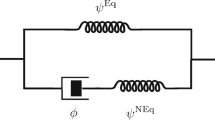Abstract
The paper discusses delayed creep failure criteria and their experimental justification. These criteria allow transition from the strength characteristics under uniaxial stress to the strength characteristics under plane stress. The criterion is chosen in the form of a mixed invariant that relates two stress components responsible for brittle and ductile failure. The limit characteristics take the effect of the principal stresses into account. The criterion was tested for isotropic metallic materials subjected to internal pressure, internal pressure with tension, pure torsion, and tension with torsion
Similar content being viewed by others
REFERENCES
S. N. Kats, “Study into the long-term strength of carbon steel pipes,” Teploénergetika, No. 11, 37-40 (1956).
S. N. Kats, “Creep failure of austenitic steel pipes under internal pressure,” Énergomashinostroenie, No. 11, 1-5 (1957).
S. N. Kats, “Influence of additional axial forces on the long-term strength of boiler pipes,” Teploénergetika, No. 5, 12-16 (1960).
V. N. Kisilevskii, V. K. Lukashev, D. V. Polevoi, B. V. Samsonov, and N. P. Losev, “Effect of reactor radiation on the long-term strength of Kh16N15M3B steel depending on the stress mode,” Probl. Prochn., No. 9, 39-42 (1974).
V. I. Krizhanovskii, “Initial relations and technique for deriving two-parameter criteria of long-term strength under biaxial stress,” Teor. Prikl. Mekh., 34, 190-195 (2001).
A. A. Lebedev, “The generalized long-term strength criterion,” in: Heat Resistance of Materials and Structural Elements [in Russian], Naukova Dumka, Kiev (1965), pp. 69-76.
A. A. Lebedev, “An experimental investigation into the long-term strength of chromium-nickel-titanium steel under biaxial tension,” in: Heat Resistance of Materials and Structural Elements [in Russian], Naukova Dumka, Kiev (1965), pp. 77-83.
A. M. Lokoshchenko, E. A. Myakotin, and S. A. Shesterikov, “Creep and long-term strength of Kh18N10T steel under complex stress,” Mekh. Tverd. Tela, No. 4, 87-94 (1979).
A. Nadai, Theory of Flow and Fracture of Solids, in two vols., McGraw-Hill, New York (1950-1963).
Yu. N. Rabotnov, Creep of Structural Elements [in Russian], Nauka, Moscow (1966).
V. P. Sdobyrev, “Long-term strength of ÉI437B alloy under complex stress,” Izv. USSR, Otd. Tekhn. Nauk, No. 4, 92-97 (1958).
V. P. Sdobyrev, “A long-term strength criterion for some heat resisting alloys under complex stress,” Izv. AN SSSR, Otd. Tekhn. Nauk, No. 6, 93-99 (1959).
I. I. Trunin, “Long-term strength assessment and some features of deformation under complex stress,” PMTF, No. 1, 110-114 (1963).
I. I. Trunin, “A creep strength criterion under complex stress,” Prikl. Mekh., 1, No. 7, 77-83 (1965).
A. Hald, Statistical Theory with Engineering Applications, John Wiley & Sons, New York, Chapman & Hall, London (1952).
Yu. N. Shevchenko, R. G. Terekhov, N. S. Braikovskaya, and S. M. Zakharov, “Study into the creep failure of an element of a body,” Prikl. Mekh., 30, No. 4, 21-40 (1994).
V. P. Golub, “Experimental analysis of high-temperature creep, fatigue, and damage. 1. Analysis methods,” Int. Appl. Mech., 37, No. 4, 425-455 (2001).
V. P. Golub, “Experimental analysis of high-temperature creep, fatigue, and damage. 2. Basic laws,” Int. Appl. Mech., 37, No. 5, 565-601 (2001).
D. R. Hayhurst, “Creep rupture under multi-axial states of stress,” J. Mech. Phys. Solids, 20, No. 6, 381-390 (1972).
A. E. Johnson and N. E. Frost, “Fracture under combined stress creep conditions of a 0.5 per cent molybdenum steel,” The Engineer, 191, 434-437 (1951).
A. E. Johnson, “Complex stress creep of metals,” Metallurgical Reviews, 5, No. 20, 447-506 (1960).
L. F. Kooistra, R. U. Blaser, and J. T. Tucker, “High-temperature stress-rupture testing of tubular specimens,” Trans. ASME, 74, No. 5, 783-792 (1952).
W. Siegfried, “Failure from creep as influenced by the state of stress,” J. Appl. Mech., 10, No. 4, 202-221 (1943).
Yu. N. Shevchenko and R. G. Terekhov, “Studying the laws of the thermoviscoplastic deformation of a solid under nonisothermal complex loading. Part 2,” Int. Appl. Mech., 37, No. 6, 701-727 (2001).
Author information
Authors and Affiliations
Rights and permissions
About this article
Cite this article
Golub, V.P., Krizhanovskii, V.I. & Rusinov, A.A. A Mixed Criterion of Delayed Creep Failure Under Plane Stress. International Applied Mechanics 39, 556–565 (2003). https://doi.org/10.1023/A:1025187509053
Issue Date:
DOI: https://doi.org/10.1023/A:1025187509053




